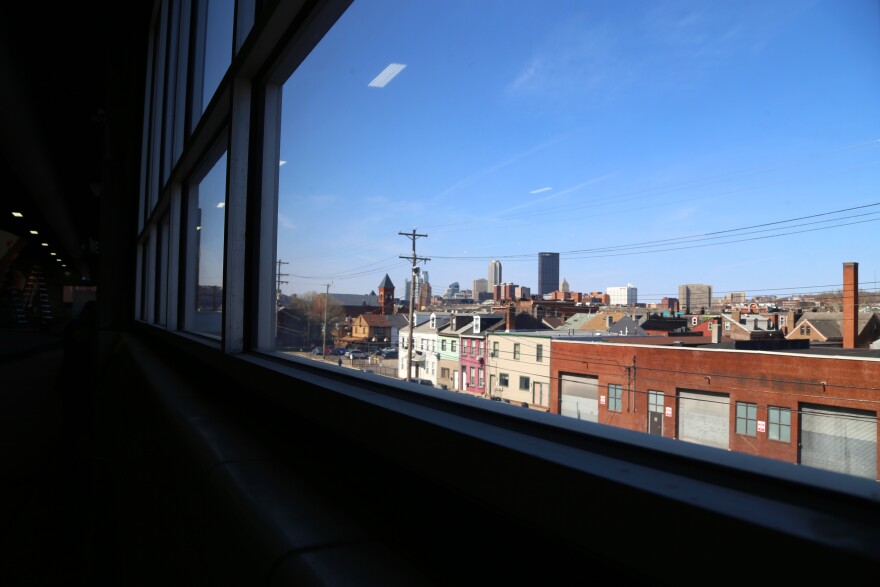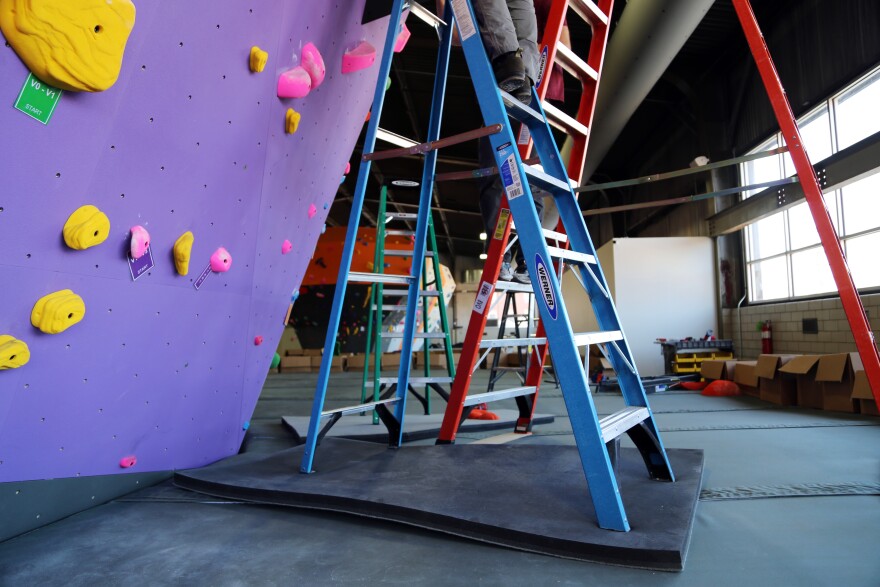Todd McCormick leaned against a freshly scrubbed, cinder block wall and jammed the toe of his shoe against speckled gym floor matting.
“Words,” he said, grinning – willing the rubber to yield. “Words cannot even express how excited I am.”
He stood back, admiring the bones of a just-assembled, secondhand weight lifting rack. From around the room, his new bosses howled.
Two months ago, the 31 year old could jog laps around the 27,000-square-foot warehouse, then just an empty concrete and red brick expanse. Today, the second-floor facility has showers, a yoga studio, child care, a strength training space and five massive, steel-framed climbing areas wreathed in Flashed padding – the dense, squishy fitness equivalent of a memory foam mattress.
And just as importantly, there are climbers.
After nearly six years, three buildings and $2 million in fundraising, Alex Bernstein, Aaron Gilmore and Paul Guarino – the three co-owners of Ascend, Pittsburgh’s newest climbing gym – finally opened their doors on Wednesday, and they’ll be the first to admit it’s been a long time coming.

Really, it’s all Bernstein’s fault. Or maybe his mom’s.
Nine years ago, he followed his big sister out to San Francisco. The family had played around at The Climbing Wall in Point Breeze – the only climbing gym in Pittsburgh for the last 25 years – before she left, so they looked up a gym out west. The California facility blew Bernstein away.
“My mother was the one who said, ‘Why doesn’t this exist in Pittsburgh?’ said Bernstein, 30, of Squirrel Hill. “And she and I started looking into things. … That was the real beginning.”

By the time Bernstein met Gilmore and Guarino, the notion had been stewing in his mind for going on four years.
The trio started planning.
“I think we thought, ‘Yeah! Some hammers, some plywood and some friends and paint, and you know, a couple hundred thousand dollars, we'll be doing this thing!’” Bernstein said. “Turns out, more like millions and a lot of salesmanship convincing friends and family and Pittsburghers that this is going to work.”
They needed to find a place that would allow basic improvements and energy and safety compliance upgrades. It needed to be structurally sound, capable of supporting weighty installations and a near-constant influx of customers.
“From early on, a lot of people said, ‘You're in Pittsburgh. Steel mills (and) warehouses are everywhere,’” Bernstein said. “Turns out, there aren't that many.”
Gilmore, 30, of Point Breeze said every building they looked at needed some combination of new windows, insulation, roofs, sprinklers, fire alarms, plumbing, exits, parking and more.
A post shared by ASCEND Pittsburgh (@ascendpgh) on Jan 23, 2017 at 6:43pm PST
“Just none of them (are compliant),” he said. “So like right off the bat, you’re looking at all these base improvements that you need to get into a building before you even can start looking at doing your business specific improvements.”
But they didn’t think it would take so long. Three years ago, they announced their imminent arrival with stickers saying, “Ascend, coming 2014.” Climbers were excited, and a couple got a little heated when the deal fell through.
That first proclamation wasn’t made in jest, Guarino said.
“We’ve had to explain to a lot of people what has gone wrong,” he said, “and sometimes it’s hard to even put into words or say it in a way that people really understand, you know, how difficult this is and how much time and money it takes to start a business, let alone a pretty big friggin’ business as your first one.”

Gilmore said he feels like customers’ anxiety speaks to Pittsburgh’s burgeoning climbing market.
“There’s a large population of people that have just been waiting for it,” he said. “Sometimes they forget that we are three guys with no money and no business experience.”
Rope-protected climbing was their priority, at first, and that meant ceilings in excess of 60 feet. Eventually, they compromised on a bouldering gym with one multi-sided top rope wall in the former bottling plant of Duquesne Brewing on Mary between 21st and 22nd streets. (Don’t fret, climbers. Give them 10 years and a growing customer base, and they said they’ll give Pittsburgh the top rope gym it deserves, but stay tuned. Also, it probably won’t be in the city.)
“It’s an inspiring space,” Bernstein said in December, standing atop what was then a newly installed concrete support pad. “It’s our magical unicorn building.”
But it’s still not exactly what they’d initially imagined.

The ceilings top out at 24 feet, and it took a lot of carefully orchestrated planning and permitting to support the immense volume of construction and installation, Bernstein said, like drilling through the floor and knocking down walls of brick nine rows thick.
“It’s just the nature of the scale of this,” he said. “The customer is never going to see the full value of what we’ve paid for construction.”
Each climbing area at Ascend is a varied landscape of obstacles, angles, holds and vertical grades. Some portions are more straight up and down, better for young people or beginning climbers. One boulder is shaped like a mushroom – a little shorter so climbers can finish on top of it and down scurry a series of easy-to-grab holds. The tallest structure is for rope-protected climbs and requires a short safety check.

And in the center is a huge arch. It’s the first thing visitors see, and then they notice the open sky behind it.
"Tons of windows," Bernstein said. "You can see Downtown and the Cathedral of Learning. It's some kind of a million-dollar view.”
About a quarter of their funding came from a Small Business Administration loan, and the rest from their very generous landlord and 30 or so family members, friends and friends of friends.
“This was never a deal for a venture capitalist, at least in the city or at least with us as newbies to the climbing gym ownership world,” Bernstein said. “But we've found enough people to believe in us. And so, so far so good.”
The climbing industry has ballooned since Bernstein and company first imagined Ascend.
An interactive map hosted through the Climbing Business Journal shows 420 indoor climbing facilities currently operating in the U.S. That’s a 9 percent increase just since 2012, with another 41 expected to open within the year.
Some cities, like several in California, Boston, Salt Lake City, Seattle, Denver and Chicago, are covered in climbing gyms. Philadelphia residents can get to 11 different gyms in an hour and a half or less. There are seven around Washington D.C. and Baltimore. Five in Minneapolis. Four each in St. Louis and Nashville. Three in Indianapolis and Louisville. The city of Pittsburgh had one.
“We are insanely appreciative of what The Climbing Wall has done for climbing in Pittsburgh,” Bernstein said.
The Climbing Wall opened in Point Breeze in 1992 when its dedicated but sometimes reclusive proprietor turned his hobby into his business at the behest of a friend who owned a building with tall ceilings and an interest in supporting youth fitness. It’s limited by space, but most Pittsburgh-area climbers go there to train.

Bernstein, McCormick and their full-time route setter, 30-year-old Brian Pascuzzi, once worked there, and until recently, they all still dropped by to climb. They say they probably still will.
The inherent intimacy of a tight-knit climbing community is part of what inspired them, Gilmore said. So from the start, the crew had just one non-negotiable: their gym had to be in Pittsburgh.
“We really wanted to grow the community here first,” Bernstein said, “and be central and be able to accommodate everybody from Cranberry and the South Hills and the East End and wherever.”
Gilmore pointed to St. Louis, “a similar kind of old industrial town that’s seen a resurgence and similar population.” It has four, soon-to-be five climbing gyms, he said.
Some aspects of Ascend’s aesthetic were inspired by conversations with gym owners in other parts of the country.
Lots of gyms use colored tape to delineate their routes, which requires climbers pay attention to where the holds are in advance of the moves, just in case the tape isn’t visible on the way up the wall. Gilmore and Pascuzzi knew they wanted to color-code their holds instead and circuit grade the difficulty of each route.


It’s cleaner, Pascuzzi said, and requires less effort on the part of the climber.
“The grades are a range, so it messes with your perception of your ability,” Gilmore said. “I might think I’m a V2 climber, but if the route is V2-V4, I have to challenge myself. We want people to challenge themselves.”
The pair set about 200 routes ahead of opening day. The initial bulk order of 6,500 blue, yellow, green, purple and orange and pink holds cost about $65,000, Guarino said, and they hope to have 10,000 by the end of 2017.
“Plus the campus board and moon board and the cardio equipment coming later this month,” he said.
At the gym, Breanna Smith, 24, said she got “super spoiled” by the extensive climbing community outside the Rochester Institute of Technology in upstate New York. She’s been back in Pittsburgh for about three years, she said, but it’s been tough to find a groove.
“I know a lot of people here who’d like to climb, but no one who wants to do it every day,” she said. “I’m just glad a place like this is finally here.”
In the early going, they plan to host extended hours every day with yoga and movement classes available at peak times.
“We want someone to be able to come here seven days a week, even if they have an injured finger and can’t actually climb,” he said. “You don’t have to cancel your membership and sit at home.”
The guys see themselves as part of a larger wave of entrepreneurship in Pittsburgh, no different than new restaurants, breweries or clothing stores. And they don’t regret planting their black and yellow flag in Pittsburgh three years ago.
It helped keep competitors away, Guarino said. They had more time to visit other climbing gyms, refine their business plan and raise more money. Now they’ve hired 40 people, signs are up and hundreds of people who’ve never seen the inside of the gym are buying memberships.
“It really is a sight to behold," Bernstein said. "I think it will take some visits from people to the gym to really be convinced that we aren't reinventing something that's already existed in Pittsburgh, that this is something new. It's bigger, it's brighter, it's different. And we hope everybody comes out and checks it out for themselves.”




















